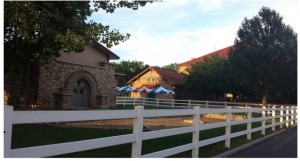As the Utah State Legislature passed the half-way mark for this year’s legislative session, the future of the Utah State Fairpark remains unresolved. A subcommittee fails to recommend that the State implement a 50-year lease as authorized in 2010. Another subcommittee considers requiring that private developers and State agencies be given the opportunity to express interest in developing the
White Ball Field.
At stake is an agreement between the Utah State Fair, Inc. and the REAL Salt Lake major-league soccer to team to construct an 8,000-seat stadium to house a new minor league soccer team, the Real Salt Lake Monarchs, at the Utah State Fairpark. The REAL Salt Lake will cover the projected $18 million cost of the new stadium.
But this agreement is contingent on several factors: First, the soccer franchise wants a lease of at least 40 years. Second, the lease must be in place by April 23, anticipating the 2017 soccer season. Finally, there is the question of the availability of the White Ball Field, the vacant property across North Temple to the south of the Fairpark, for parking.
A 40-year lease for the soccer team is impossible unless the lease the Utah State Fair, Inc. has with the State for the use of the Fairpark is extended for at least 40 years. In recent years, the nonprofit corporation has operated with much shorter leases with the State. Its current lease expires 2017. The Utah State Fair, Inc. is also approaching the Legislature for $675,000 for ongoing maintenance and improvement of Utah State Fairpark property and $100,000 to conduct a study on the best ways to enlarge the Fairpark’s rodeo grandstand.
To-date, the Utah State Fair experienced a set-back with the failure of the Natural Resources, Agriculture, Environmental Quality Appropriations Subcommittee toendorse a motion to require the State to sign a 50-year lease for the Fairpark, as was authorized by the Legislature in 2010.
Another complicating factor is that, several years ago, the lease for the use of the White Ball Field for parking was separated from the lease for the Fairpark property. In the current arrangement, the State can assume direct control of the White Ball Field with just a 30-day notice.
As a result, a new challenge to the Utah State Fair/ REAL Salt Lake deal is that members of the Legislative appropriations subcommittee, Infrastructure and General
Government, have expressed concern with leasing the White Ball Field to the Utah State Fair, Inc. for parking without opening up a “Request for Information” process for others, including the State of Utah, to state an interest in using the property for other purposes. For example, in last year’s study on possible future uses of the White Ball Field and the Utah Fairpark, the State’s need for more office
space was identified as a possible use for the property. According to State administrators, this process will take three to five months, a time-frame that extends well beyond the April 23rd agreement with the Utah State Fair, Inc.
This year’s session of the Utah Legislature ends at midnight on March 12th. No issue is closed until this day. In the discussions in the Legislative subcommittees, the support of the communities surrounding the Utah Fairpark has been
continually mentioned. It is important that the Fairpark Community continues to express its hopes for the future of the Fairpark.
To keep up-to-date on the status of Utah Fairpark issues in the Legislature and what actions residents can take to support a successful future for the Fairpark, visit fairparkcommunity.org.











